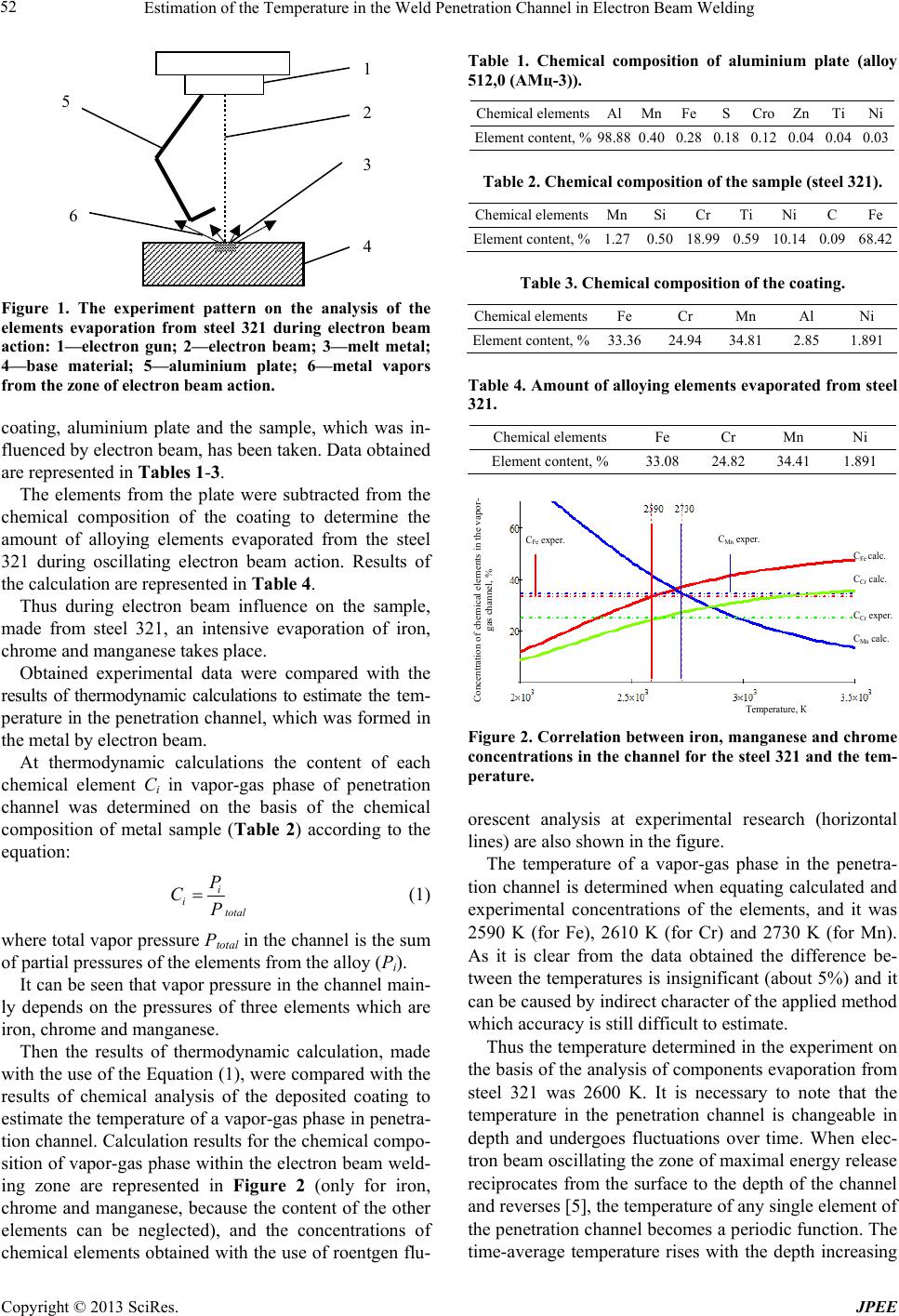
Estimation of the Temperature in the Weld Penetration Channel in Electron Beam Welding
Copyright © 2013 SciRes. JPEE
Figure 1. The experiment pattern on the analysis of the
elements evaporation from steel 321 during electron beam
action: 1—electron gun; 2—electron beam; 3—melt metal;
4—base material; 5—aluminium plate; 6—metal vapors
from the zone of electron beam action.
coating, aluminium plate and the sample, which was in-
fluenced by electron beam, has been taken. Data obtained
are represented in Tables 1-3.
The elements from the plate were subtracted from the
chemical composition of the coating to determine the
amount of alloying elements evaporated from the steel
321 during oscillating electron beam action. Results of
the calculation are represented in Table 4.
Thus during electron beam influence on the sample,
made from steel 321, an intensive evaporation of iron,
chrome and manganese takes place.
Obtained experimental data were compared with the
results of thermodynamic calculations to estimate the tem-
perature in the penetration channel, which was formed in
the metal by electron beam.
At thermodynamic calculations the content of each
chemical element Сi in vapor-gas phase of penetration
channel was determined on the basis of the chemical
composition of metal sample (Table 2) according to the
equation:
(1)
where total vapor pressure Ptotal in the channel is the sum
of partial pressures of the elements from the alloy (Рi).
It can be seen that vapor pressure in the channel main-
ly depends on the pressures of three elements which are
iron, chrome and manganese.
Then the results of thermodynamic calculation, made
with the use of the Equation (1), were compared with the
results of chemical analysis of the deposited coating to
estimate the temperature of a vapor-gas phase in penetra-
tion channel. Calculation results for the chemical comp o-
sition of vapor-gas phase within the electron beam weld-
ing zone are represented in Figure 2 (only for iron,
chrome and manganese, because the content of the other
elements can be neglected), and the concentrations of
chemical elements obtained with the use of roentgen flu-
Table 1. Chemical composition of aluminium plate (alloy
512,0 (AМц-3)).
Chemical elements Al Mn Fe S Crо Zn Ti Ni
Element content, % 98.88
0.40 0.28 0.18 0.12 0.04 0.04 0.03
Table 2. Chemical composition of the sample (steel 321).
Chemical elements Mn Si Cr Ti Ni C Fe
Element content, % 1.27 0.50 18.99 0.59 10.14 0.09 68.42
Table 3. Chemical composition of the coating.
Chemical elements Fe Cr Mn Al Ni
Element content, % 33.36 24.94 34.81 2.85 1.891
Table 4. Amount of alloying elements evaporated from steel
321.
Chemical elements Fe Cr Mn Ni
Element content, % 33.08 24.82 34.41 1.891
Figure 2. Correlation between iron, manganese and chrome
concentrations in the channel for the steel 321 and the tem-
perature.
orescent analysis at experimental research (horizontal
lines) are also shown in the figure.
The temperature of a vapor-gas phase in the penetra-
tion channel is determined when equating calculated and
experimental concentrations of the elements, and it was
2590 K (for Fe), 2610 K (for Cr) and 2730 K (for Mn).
As it is clear from the data obtained the difference be-
tween the temperatures is insignificant (about 5 %) and it
can be caused by indirect character of the applied method
which accuracy is still difficult to estimate.
Thus the temperature determined in the experiment on
the basis of the analysis of components evaporation from
steel 321 was 2600 K. It is necessary to note that the
temperature in the penetration channel is changeable in
depth and undergoes fluctuations over time. When elec-
tron beam oscillating the zone of maximal energy release
reciprocates from the surface to the depth of the channel
and reverses [5], the temperature of any single element of
the penetration channel becomes a periodic function. The
time -average temperature rises with the depth increasing
Concentration of chemical elemen ts in the vapor-
gas channel , %
С
Fe
calc.
C
Cr
calc.
С
Cr
exper.
C
Mn
calc.